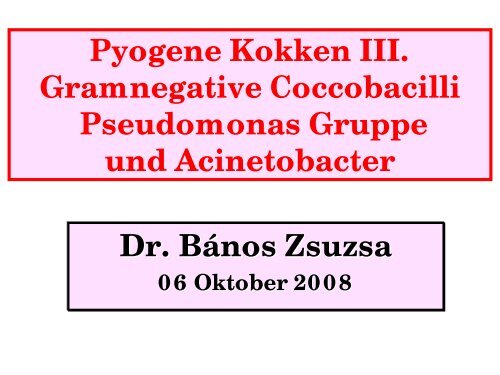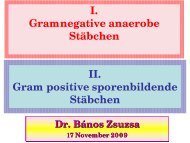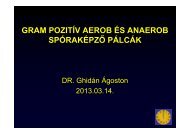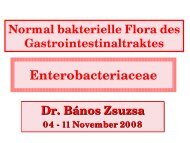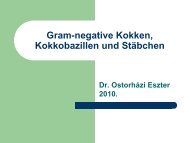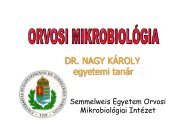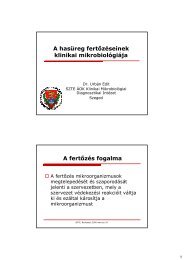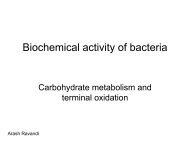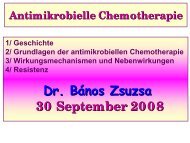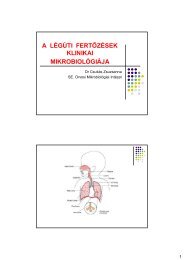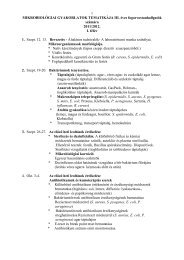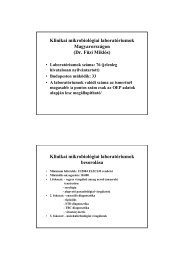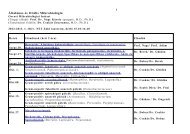Pseudomonas aeruginosa
Pseudomonas aeruginosa
Pseudomonas aeruginosa
You also want an ePaper? Increase the reach of your titles
YUMPU automatically turns print PDFs into web optimized ePapers that Google loves.
Pyogene Kokken III.<br />
Gramnegative Coccobacilli<br />
<strong>Pseudomonas</strong> Gruppe<br />
und Acinetobacter<br />
Dr. Bános Zsuzsa<br />
06 Oktober 2008
Neisseria, Haemophilus,<br />
Bordetella<br />
1. Neisseria
Pyogene Kokken GRAM -<br />
Aerob: Oxidase +<br />
Neisseria N. gonorrhoeae P<br />
N. meningitidis P<br />
andere (N. sicca, N. subflava, N. flavescens und<br />
apathogene Arten)<br />
Moraxella M. catarrhalis<br />
Anaerob: Veillonella spp.<br />
Veillonellen vietsciences.free.fr
N. gonorrhoeae und N. meningitidis<br />
Morphologie<br />
Gramnegative<br />
Diplokokken<br />
www.waterscan.co.yu/images
Gramnegative Diplokokken<br />
path.upmc.edu
N. gonorrhoeae und N. meningitidis<br />
Kultur:<br />
Spezial Anspruchsvolle<br />
Bakterien<br />
Angereicherte Medien<br />
(Kochblutagar 5-10% CO 2 )<br />
Resistenz:<br />
Sind wenig resistent<br />
gegenüber Austrockung,<br />
Hitze, Desinfektionsmittel,<br />
Antibiotika<br />
Oxidase +<br />
path.upmc.edu
http://www.mfi.ku.dk/ppaulev/chapter33/images/33-3.jpg
N. gonorrhoeae = Gonococcus<br />
Antigene und Virulenzfaktoren:<br />
Pili/Fimbriae (Antigenvariationen!)<br />
IgA-Proteasen!<br />
outer membrane proteins (OMP)<br />
(Antigenvariationen!)<br />
LOS (Mimikri!)<br />
Zellwand Peptidoglycan (Toxische Wirkung)
N. gonorrhoeae = Gonococcus
N. gonorrhoeae = Gonococcus<br />
Pili<br />
textbookofbacteriology.net
N. gonorrhoeae = Gonococcus<br />
Gonococcus-Lymphozyt Interaktion<br />
neisseria.org/images/ng-lym2.jpg
N. gonorrhoeae = Gonococcus<br />
Infektionsquelle<br />
erkrankte Menschen<br />
Übertragung<br />
-Direkter (sexueller) Kontakt<br />
Krankheitsbilder<br />
Gonorrhea = Gonorrhö = Tripper<br />
Ophthalmoblenorrhea neonatorum<br />
Generalisation 1%<br />
KEINE IMMUNITÄT!<br />
(Antigenvarianten!)
Die Erreger des Trippers (Neisseria gonorrhoeae, hier blau)<br />
werden von fingerförmigen Fortsätzen auf der Zelloberfläche<br />
(grün) umschlossen. Im weiteren Verlauf der Infektion dringen<br />
die Bakterien dann in die Zelle ein.<br />
Max-Planck-Institut für Infektionsbiologie, Volker Brinkmann
Pathogenese<br />
Medmicro
Gonorrhea – akute Urethritis<br />
www.stdservices.on.net<br />
www.boltonlgb.co.uk
Gonorrhea – akute Urethritis
Gonorrhea – akute Cervicitis<br />
www.boltonlgb.co.uk
Gonorrhea – akute Cervicitis
Gonorrhea – akute Conjuctivitis<br />
Blenorrhea neonatorum<br />
www.mc3.edu<br />
Corneal ulcers due to<br />
gonococcus are very<br />
destructive and have a<br />
tendency to perforate the<br />
cornea.<br />
www.slackbooks.com
Gonorrhea – Kronische und disseminierte Formen<br />
Endometritis,<br />
Salpingitis,<br />
Prostatitis<br />
purulent Arthritis,<br />
Vasculitis<br />
Wichtig!<br />
anorectal Go und Pharyngitis<br />
(„alternative Genitalien”)
Fig. 8.33 Gonococcal<br />
septic arthritis. Arthritis<br />
due to N. gonorrhoeae in<br />
a 24-year-old woman,<br />
showing marked erythema<br />
and swelling of the right<br />
ankle and leg. By courtesy<br />
of Dr. T.F. Sellers Jr.<br />
Fig. 8.33 Gonococcal<br />
arthritis. Dactylitis<br />
secondary to gonococcal<br />
bacteriaemia. By courtesy<br />
of Dr. S.E. Thompson
Gonorrhea – Diagnose – nur bei akuten Krankheiten<br />
Mikroskopisch<br />
Nachweis des Erregers<br />
Gramfärbung<br />
www2.mf.uni-lj.si,<br />
www.uni-ulm.de,<br />
pathmicro.med.sc.edu<br />
Methylenblau Färbung, Direkt Immunoflueroscenz (DIF)
GO – Gramfärbung – nur vorherige Diagnose!
GO – Gramfärbung – nur vorherige Diagnose!<br />
www.med.uni-giessen.de
Gonorrhea – Diagnose<br />
Kultur:<br />
„bedside” Thayer-Martin medium<br />
und Kochblutagar, 5% CO2<br />
Identifizierung: ox+, glu+, mal-<br />
Antigennachweis:<br />
Latex-agglutination<br />
www2.mf.uni-lj.si,<br />
www.uni-ulm.de,<br />
pathmicro.med.sc.edu
Therapie:<br />
3. Generation Cephalosporin (Ceftriaxone)<br />
oder Spectinomycin (Aminoglycoside)<br />
Prophylaxe:<br />
GO<br />
- Vermeidung infektiöser Kontakte<br />
(safe sex)<br />
- Erfassung und Sanierung aller Infektionsquelle<br />
- Frühe Diagnose und Behandlung<br />
Ophthalmia neonatorum:<br />
Applikation von 1% Silbernitrat in Conjunctivasack<br />
Keine Schutzimpfung! (Antigenvarianten!)<br />
Gonorrhea<br />
www.tiscali.co.uk
N. meningitidis = Meningococcus<br />
scanning EM<br />
textbookofbacteriology.net
N. meningitidis = Meningococcus<br />
Antigene und Virulenzfaktoren:<br />
Kapsel – Polysaccharide<br />
12 Serotyp (A, B, C, W135, Y!)<br />
Pili/Fimbriae<br />
IgA-Proteasen!<br />
Outer Membrane Proteine (OMP)<br />
LOS (Mimkri, sialisiert ist Serum resisitent!)
Meningococcus<br />
zdsys.chgb.org.cn
N. meningitidis = Meningococcus<br />
Infektionsquelle<br />
Menschen – Keimträger (erkrankte, gesund)<br />
Übertragung, Eintrittspforte<br />
- Direkt, Tröpfcheninfektion<br />
- Nasen-, Rachenraum<br />
Krankheitsbilder<br />
Pharyngitis<br />
Meningitis cerebrospinalis epidemica<br />
Sepsis = Waterhouse-Friderichsen Syndrom
Fig. 10.56 Acute meningococcaemia. Note the variable size of the lesions and<br />
their peripheral distribution. Some of the lesions are obviously purpuric, others<br />
macular or papular.
Fig. 10.60 Acute meningococcaemia. Petechia on bulbar conjunctiva.
Fig. 10.62 Acute meningococcaemia. Gangrene of the extremities following a<br />
near-fatal illness with hypotension.
Fig. 10.63 Acute meningococcaemia. Gangrene of both legs in a black man<br />
with acute meningococcal infection. Bilateral below knee amputations were<br />
later required.
The characteristic skin rash of meningococcal septicaemia, caused by<br />
Neisseria meningitidis. (Courtesy of Wellcome Trust Photographic Library)<br />
srs.dl.ac.uk
Waterhouse – Friderichsen Syndrom - diagnose<br />
www.lboro.ac.uk
Waterhouse- Friderichsen Syndrome: schwere nekrotisierende<br />
Hautläsionen bei Meningokokkensepsis mit Verbrauchskoagulopathie<br />
(R. E. Rieger, Univ.-Kinderklinik Marburg).<br />
© Urban & Fischer 2003 – Roche Lexikon Medizin, 5. Aufl.<br />
www.gesundheit.de
The patient with Waterhouse-Friderichsen syndrome has sepsis<br />
with DIC and marked purpura.<br />
medlib.med.utah.edu
Purulent meningitis with hemorrhage in the frontal lobe (gross findings).<br />
pathy.fujita-hu.ac.jp
Acute hemorrhage in bilateral adrenals caused acute adrenal<br />
insufficiency (Waterhouse-Friderichsen syndrome).<br />
pathy.fujita-hu.ac.jp
Untersuchungsmaterialen:<br />
Liquor! - Lumbalpunction<br />
Blut<br />
Keimträger: Rachenabstrich<br />
Meningitis Diagnose
Meningitis Diagnose<br />
Nachweis des Erregers<br />
Mikroskopische Untersuchung<br />
(Liquor, Blutkultur)<br />
Kultur<br />
Liquor, Blut, Rachen<br />
Direkt Ag Nachweis<br />
(Liquor) – Latex-agglutination
Kultur: Blutagar,<br />
Kochblutagar<br />
Identifizierung:<br />
glu+, mal+<br />
MIC (E-test)<br />
Diagnose<br />
N. meningitidis
Meningococcus meningitis<br />
Therapie:<br />
Penicilline und/oder<br />
Cephalosporine (III. Gen.)<br />
Keine Beta-lactamase Bildung<br />
Prophylaxe:<br />
Aktive Immunisierung<br />
Schutzimpfung für:<br />
- Risikogruppen<br />
- Reisender<br />
(Meningitisgürtel!)<br />
Chemoprophylaxe:<br />
Rifampicin (Kontakte)
Meningitisgürtel
Neisseria meningitidis - B<br />
Europa!<br />
Keine Schutzimpfung!<br />
Rifampicin<br />
www.versapharm.com
Neisseria, Haemophilus,<br />
Bordetella<br />
2. Haemophilus
KLEINE GRAMNEGATIVE STÄBCHEN<br />
Gattung Art<br />
Haemophilus H. influenzae P<br />
H. parainfluenzae<br />
H. aegyptius P<br />
H. ducreyi P<br />
Bordetella B. pertussis P<br />
B. parapertussis<br />
P: Pathogen
Haemophilus influenzae<br />
Morphologie:<br />
Gram - Coccobacillus,<br />
ca. 1 μm<br />
Kultivierung:<br />
Wachstumsfaktoren !<br />
(Kochblutagar,<br />
X= Haem, V= NAD,<br />
Satellitenphänomen,<br />
„Ammenphänomen”)<br />
www.waterscan.co.yu/images
phil.cdc.gov<br />
Blood agar plate culture showing Haemophilus influenzae<br />
satelliting around Staphylococcus aureus.
Haemophilus influenzae<br />
Antigene und Virulenzfaktoren:<br />
Kapsel – Polysaccharid<br />
Typen: a, b, c, d, e, f (HiB!)<br />
IgA-Proteasen!<br />
Körperantigene:<br />
Outer Membrane Proteine (OMP)<br />
LPS
Haemophilus<br />
influenzae Typ b<br />
(Hib)<br />
www.soundmedicine.iu.edu
Haemophilus influenzae<br />
Krankheitsbilder:<br />
Meningitis, Sepsis<br />
Cellulitis<br />
Obere Luftwege:<br />
Epiglottitis!, Nasopharyngitis, Sinusitis, Otitis media<br />
Untere Luftwege:<br />
Bronchitis, Pneumonie,
Haemophilus influenzae<br />
Sepsis<br />
An infant with severe vasculitis with disseminated intravascular coagulation (DIC) with<br />
gangrene of the hand secondary to Haemophilus influenzae type b septicemia - prior to<br />
the availability of the Hib vaccine.<br />
-Image provided by: Visual Red Book on CD-ROM-<br />
www.ecbt.org<br />
-(2000 Red Book: 25th Edition, Report of the Committee on Infectious Diseases)
Haemophilus influenzae<br />
Periorbital cellulitis.<br />
© Neal Halsy, MD www.cispimmunize.org
Haemophilus influenzae<br />
Krankheitsbilder:<br />
Meningitis, Sepsis<br />
Cellulitis<br />
Obere Luftwege:<br />
Epiglottitis!, Nasopharyngitis, Sinusitis, Otitis media<br />
Untere Luftwege:<br />
Bronchitis, Pneumonia,
HIB-epiglottitis
Haemophilus influenzae<br />
Diagnose:<br />
Untersuchungsmaterial<br />
LIQUOR! (CSF)<br />
Proben aus Infektionsort (Nase, Rachen, Sputum etc.)<br />
Erregernachweis:<br />
Mikroskopie, Züchtung,<br />
Kapsel Ag detektion (Latex-agglutination)<br />
Therapie:<br />
1. Ampicillin + III. gen. Cephalosporine<br />
2. Ampicillin + Aminoglycoside<br />
Prophylaxe:<br />
Aktive Immunisierung - HiB Konjugat-Vakzine<br />
(Polysaccharide + Protein)
Lipopolysaccharid<br />
Extrakt - Vakzine<br />
ibs-isb.nrc-cnrc.gc.ca<br />
www.kmhk.kmu.edu.tw
Haemophilus ducreyi<br />
Krankheitserreger von Ulcus molle = Chancroid =<br />
= weicher Schanker<br />
Haemophilus aegyptius<br />
Krankheitserreger von Brasilianische Purpuric Fieber<br />
Haemophilus parainfluenzae<br />
Pharyngitis, Endocarditis, Konjunktivitis
Ulcus molle
Ulcus molle
medinfo.ufl.edu
Chancroid in female<br />
www.smu.edu
Neisseria, Haemophilus,<br />
Bordetella<br />
3. Bordetella
KLEINE GRAMNEGATIVE STÄBCHEN<br />
Gattung Art<br />
Haemophilus H. influenzae P<br />
H. parainfluenzae<br />
H. aegyptius P<br />
H. ducreyi P<br />
Bordetella B. pertussis P<br />
B. parapertussis<br />
P: Pathogen
Bordetella pertussis<br />
Morphologie:<br />
Gramnegative<br />
Coccobacillus,<br />
ca. 1 μm<br />
www.waterscan.co.yu/images
Bordetella pertussis<br />
Kultur:<br />
Spezial Medien<br />
Bordet – Gengou<br />
nobelprize.org<br />
www.szu.cz
Bordetella pertussis<br />
Antigene und Virulenzfaktoren:<br />
Kapsel<br />
Fimbriae, filamentöses Haemagglutinin<br />
Outer Membrane Proteine (OMP)<br />
LPS<br />
Pertactin<br />
Extrazelluläre Toxine:<br />
Pertussis Toxin<br />
Adenylatzyklase Toxin<br />
Tracheales Zytotoxin<br />
Dermatonekrotisches Toxin
FIGURE 31-2 Virulence factors of B pertussis.<br />
Medmicro
Pertussis toxin<br />
www.med.sc.edu:85
Bordetella pertussis<br />
Pathogenese, Infektion:<br />
Infektionsquelle: Kranke – in prodromalen und<br />
katarrhalischen Stadium<br />
Eintrittspforte: Respirationstrakt<br />
Übertragung: Tröpfcheninfektion → sensitive!<br />
55°C; 30’
FIGURE 31-1 Pathogenesis of whooping cough.<br />
Medmicro
www.my-pharm.ac.jp
FIGURE 31-3 Binding of pertussis toxin to cell membranes.<br />
Medmicro
FIGURE 31-4 Synergy between pertussis toxin and the<br />
filamentous hemagglutinin in binding to ciliated<br />
respiratory epithelial cells.<br />
Medmicro
Bordetella pertussis<br />
Krankheitsbild:<br />
Keuchhusten / Pertussis<br />
(Peribronchial Entzündung, Interstiziale Pneumonie)<br />
4-Phasen:<br />
Prodromalen,<br />
Katarrhalische,<br />
Paroxysmalen,<br />
Konvalescent<br />
Colonization of tracheal epithelial cells by B. pertussis web.umr.edu/~microbio
Pertussis –<br />
paroxysmale Phase<br />
www.gesundes-kind.de,<br />
www.vaccineinformation.org
www.med.sc.edu<br />
www.thecrookstoncollection.com<br />
Lymphozytose<br />
Pertussis - Diagnose<br />
aapredbook.aappublications.org
Bordetella pertussis<br />
Diagnose<br />
Kultur:<br />
Bordet – Gengou<br />
Direkt Anhusten!<br />
Charcoal Medium<br />
Serologie:<br />
IgM, IgA, IgG Nachweis<br />
PCR<br />
medinfo.ufl.edu
Bordetella pertussis<br />
Therapie:<br />
Makrolide<br />
Prophylaxe:<br />
Aktive Immunisierung – azelluläre Vakzine DaPT<br />
Toxoid<br />
FH/Pilus<br />
Pertactin
AEROB<br />
Bordetella<br />
Brucella<br />
Francisella<br />
GRAMNEGATIVE STÄBCHEN<br />
<strong>Pseudomonas</strong><br />
Acinetobacter<br />
Legionella<br />
FAKULTATIV ANAEROB<br />
Haemophilus<br />
Pasteurella<br />
Familie:<br />
Enterobacteriaceae<br />
Vibrionaceae<br />
Cardiobacterium<br />
Eikenella<br />
Kingella<br />
Actinobacillus<br />
ANAEROB<br />
Bacteroides<br />
Prevotella<br />
Porphyromonas<br />
Fusobacterium<br />
MIKROAEROPHIL<br />
Campylobacter<br />
Helicobacter
<strong>Pseudomonas</strong> Gruppe<br />
<strong>Pseudomonas</strong> P. <strong>aeruginosa</strong><br />
Burkholderia B. mallei P<br />
B. pseudomallei P<br />
B. cepacia<br />
Stenotrophomonas S. maltophilia<br />
(Xanthomonas)<br />
P = pathogen
<strong>Pseudomonas</strong> <strong>aeruginosa</strong><br />
Morphologie und Kultur:<br />
Gramnegative Stäbchen 1-2 μm,<br />
Anspruchslos; Biofilmbildung!
<strong>Pseudomonas</strong> <strong>aeruginosa</strong><br />
Pigmente:<br />
1. Pyocianin<br />
2. Fluorescein<br />
Haemolyse (β)
<strong>Pseudomonas</strong> <strong>aeruginosa</strong><br />
SEHR RESISTENT !<br />
-Recht resistent gegenüber<br />
Hitze<br />
Licht<br />
Austrocknung<br />
Desinfektionsmittel<br />
Antibiotika
<strong>Pseudomonas</strong> <strong>aeruginosa</strong><br />
ANTIGENE UND VIRULENZFAKTOREN:<br />
Adhäsion und Kolonisation<br />
- "0", "H", Pili/Fimbriae<br />
- Kapsel = Glycocalyx<br />
- Alginate slime = mukoid Exopolysaccharid Biofilmbildung<br />
Invasion, Penetration<br />
- Extrazelluläre Proteasen, Exoenzyme (viele!)<br />
- Cytotoxin = Leukocidin und Haemolysine<br />
-Pigmenten<br />
Dissemination<br />
- Exotoxin A – hemmt Proteinsynthese (EF2 – wie Diphtherie)<br />
- Exotoxin/Exoenzym S – bei Verbrennung; Nachweis im Blut<br />
- Endotoxin<br />
LD50 – bei Verbrennungswunde 30<br />
Normale Haut 10 8
Extrazelluläre Substanzen<br />
Pili/Fimbriae (Adherenz)<br />
Flagellum (Motilität) Kapsel;<br />
Alginate slime<br />
<strong>Pseudomonas</strong> <strong>aeruginosa</strong> – Struktur<br />
Medmicro
No single factor is<br />
decisive for virulence.<br />
www.ratsteachmicro.com
Hemmung von Proteinsynthese<br />
<strong>Pseudomonas</strong> <strong>aeruginosa</strong><br />
Toxin-A Wirkungsmechanismus<br />
Inaktiv Molekül<br />
<strong>Pseudomonas</strong> <strong>aeruginosa</strong> – elmi
<strong>Pseudomonas</strong> <strong>aeruginosa</strong><br />
Pathogenese, Infektion:<br />
Vorkommen:<br />
Boden, Wasser (Schwimmbad, Pools!), Abwässer<br />
Darmtrakt der Menschen<br />
Respirationstrakt: Tiere<br />
Infektionsquelle:<br />
Kranke, Keimträger<br />
Kontaminierte Gegenstände<br />
Lösungen (feuchtes Milieu!) Kunststoffe<br />
Übertragung: direkter, indirekter Kontakt
<strong>Pseudomonas</strong> <strong>aeruginosa</strong><br />
Krankheitsbilder:<br />
Krankenhausinfektionen<br />
- Meningitis, Pneumonie (Respirator!)<br />
-Sepsis<br />
- Verbrennung! Haut, Wunden<br />
- Urogene Infektionen (Katheter),<br />
- Darminfektionen (!), Säuglinge<br />
- Otitis media, externa<br />
- Augen + Kontaktlinsen<br />
Zystische Fibrose (mukoide Stämme)
Fig. 10.2 <strong>Pseudomonas</strong> folliculitis. Papulopustuler rash over the<br />
buttocks and thights following use of a spa pool.
Fig. 13-6 Ecthyma gangrenosum. Necrotic round lesion on the buttock of a child<br />
with <strong>Pseudomonas</strong> septicaemia associated with immunodeficiency.
Fig. 12.46 Bacterial keratitis. Contact lens-associated keratitis due to<br />
<strong>Pseudomonas</strong> <strong>aeruginosa</strong>. By courtesy of Dr. A.N. Carlson
Thinned corneal stoma<br />
Diffuse<br />
infiltrate<br />
Edge of<br />
epithelium<br />
Fig. 12.47 Bacterial keratitis, in this case due to P. <strong>aeruginosa</strong>. An<br />
infiltrate is seen with corneal thinning. By courtesy of Mr. P.A. Hunter
Fig. 12.48 Bacterial keratitis. A massive inflammatory response in<br />
anterior uveitis leads to precipitation of the cells as pus in the anterior<br />
chamber. This is called hypopyon. By courtesy of Mr. S. Harding
Fig. 12.49 Bacterial keratitis. P. <strong>aeruginosa</strong> eye infection showing<br />
corneal ulceration and hypopyon formation in this rapidly progressive<br />
eye infection.
<strong>Pseudomonas</strong> <strong>aeruginosa</strong><br />
Krankheitsbilder:<br />
Krankenhausinfektionen!<br />
Meningitis, Pneumonie (Respirator!)<br />
Sepsis<br />
Verbrennung! Haut, Wunden,<br />
Urogene Infektionen (Katheter),<br />
Darminfektionen (!), Säuglinge<br />
Otitis media, externa<br />
Augen + Kontaktlinsen<br />
Zystische Fibrose = Mukoviscidose<br />
(mukoide Stämme)
<strong>Pseudomonas</strong> <strong>aeruginosa</strong>
<strong>Pseudomonas</strong> <strong>aeruginosa</strong><br />
Diagnose:<br />
Erregernachweis, Identifizierung, Oxidase +<br />
Therapie und Prophylaxe:<br />
Antibiogram!!!<br />
Aminoglykoside, Carbenicillin,<br />
antipseudomonas Cephalosporine, Fluoroquinolone<br />
Expositionsprophylaxe: Sauberkeit. Desinfektion.<br />
Aktive Immunisierung – in Zystischer Fibrose
Vakzine<br />
A conjugate vaccine in the final clinical phase is Aerugen®, the first and only<br />
vaccine for the prophylaxis of fatal <strong>Pseudomonas</strong> <strong>aeruginosa</strong> infections in cystic<br />
fibrosis patients. The polyvalent conjugate vaccine combines 8 prevalent P.<br />
<strong>aeruginosa</strong> serotypes and the bacterial exotoxin A. It is the first conjugate<br />
vaccine based on a lipopolysaccharide component.<br />
www.bernabiotech.com
Acinetobacter spp.<br />
Morphologie:<br />
Gramnegative dimorph<br />
Stäbchen, Coccobacilli<br />
www.acinetobacter.org
Acinetobacter spp.<br />
Kultur:<br />
Agar, Blutagar<br />
Wichtig: Temperatur 40-44°C<br />
Nicht beweglich – „akinetisch”<br />
Pathogenese und Krankheitsbilder:<br />
wie bei <strong>Pseudomonas</strong> <strong>aeruginosa</strong><br />
Krankenhausinfektionen<br />
Multiresistent!<br />
www.acinetobacter.org
Normal bakterielle Flora des<br />
Gastrointestinaltraktes<br />
Enterobacteriaceae<br />
Dr. Bános Zsuzsa<br />
06 Oktober 2008
AEROB<br />
Bordetella<br />
Brucella<br />
Francisella<br />
GRAMNEGATIVE STÄBCHEN<br />
<strong>Pseudomonas</strong><br />
Acinetobacter<br />
Legionella<br />
FAKULTATIV ANAEROB<br />
Haemophilus<br />
Pasteurella<br />
Familie:<br />
Enterobacteriaceae<br />
Vibrionaceae<br />
Cardiobacterium<br />
Eikenella<br />
Kingella<br />
Actinobacillus<br />
ANAEROB<br />
Bacteroides<br />
Prevotella<br />
Porphyromonas<br />
Fusobacterium<br />
MIKROAEROPHIL<br />
Campylobacter<br />
Helicobacter
Normal bakterielle Flora des Dickdarmes in<br />
Erwachsenen (>400 Species)<br />
Anaerobe<br />
90–95% der Arten<br />
∼ 10 11 cfu/g im Stuhl<br />
Resident<br />
Bifidobacterium bifidum<br />
Bacteroides fragilis<br />
Eubacterium spp.<br />
Clostridium spp.<br />
Transient<br />
Anaerobe Kokken<br />
Fusobakterien<br />
Lactobacillen<br />
Fakultativ anaerobe<br />
5–10% der Arten<br />
∼ 10 3 –10 9 cfu/g im Stuhl<br />
Resident<br />
Escherichia coli<br />
Enterococcus spp.<br />
Transient<br />
Klebsiella spp.<br />
Enterobacter spp.<br />
Proteus spp.<br />
Providencia spp.<br />
<strong>Pseudomonas</strong> spp.<br />
Bacillus spp.<br />
Hefen, Protozoen<br />
Hahn: Tab.3.2
Bedeutung der normal Darmflora<br />
Abbau von Nahrungsmittel<br />
Bildung von Vitaminen: K & B-Komplex<br />
Gasbildung ⇒ Normal Peristaltik<br />
Ständige physische & chemische Stimuli ⇒<br />
ständige Mukosa Turnover<br />
Biofilmbildung, Blockierung von epithelialen<br />
Rezeptoren, Rivalität für Nährstoffe ⇒<br />
Hemmung von Kolonisation pathogener<br />
Bakterien<br />
Ständige Antigenstimulus ⇒ Entwicklung von<br />
Immunsystem
Gramnegative fakultativ<br />
anaerobe Stäbchen<br />
Enterobacteriaceae
Enterobacteriaceae<br />
Morphologie: - Gram negative Stäbchen<br />
- Geißel<br />
(Ausnahme: Klebsiella, Shigella)<br />
Züchtung:<br />
Einfach, übliche (Agar, Blutagar) Medien<br />
Differenzierung: pathogene-fakultativ pathogene<br />
(Biochemische Leistungen)<br />
a) Selektiv-Medien<br />
b) Differential-Medien<br />
c) Indikator-Medien
Enterobacteriaceae<br />
Antigene und Virulenzfaktoren:<br />
O (Zellwand)<br />
H (Flagella)<br />
K (Kapsel)<br />
Oberflächliche Proteine<br />
Pili<br />
Exotoxine<br />
Endotoxine
Enterobacteriaceae<br />
Fakultativ pathogene<br />
Gattungen<br />
Escherichia<br />
Klebsiella Gruppe<br />
Enterobacter<br />
Edwardsiella<br />
Citrobacter<br />
Proteus Gruppe<br />
Serratia<br />
Providencia<br />
Morganella<br />
Obligat pathogene (Gattungen)<br />
E. Coli<br />
ETEC (enterotoxische)<br />
EPEC (enteropathogene)<br />
EIEC (enteroinvasive)<br />
EHEC (enterohemorrhagische)<br />
EAggEC (enteroaggregativ)<br />
Shigella<br />
S. dysenteriae<br />
S. flexneri<br />
S. boydii<br />
S. sonnei<br />
Salmonella<br />
S. typhi<br />
S. paratyphi<br />
Yersinia<br />
Y. pestis<br />
Y. pseudotuberculosis<br />
Y. enterocolitica
Enterobacteriaceae - Fakultativ Pathogene<br />
Klebsiella, Proteus, Escherichia u. a.<br />
Extraintestinale Krankheitsbilder – eitrige Infektionen:<br />
a) Harnwegsinfektionen<br />
b) Cholecystitis<br />
c) Peritonitis<br />
d) Pneumonie<br />
e) Meningitis<br />
f) Wundinfektionen<br />
g) Sepsis<br />
h) Iatrogene/nosokomiale Infektionen<br />
Diagnose: Isolierung, Identifizierung<br />
Behandlung: Antibiogram (ESBL!)
Enterobacteriaceae<br />
Fakultativ pathogene<br />
Gattungen<br />
Escherichia<br />
Klebsiella Gruppe<br />
Enterobacter<br />
Edwardsiella<br />
Citrobacter<br />
Proteus Gruppe<br />
Serratia<br />
Providencia<br />
Morganella<br />
Obligat pathogene (Gattungen)<br />
Escherichia coli<br />
ETEC (enterotoxisch)<br />
EPEC (enteropathogene)<br />
EIEC (enteroinvasive)<br />
EHEC (enterohemorrhagisch)<br />
EAggEC (enteroaggregativ)<br />
Shigella<br />
S. dysenteriae<br />
S. flexneri<br />
S. boydii<br />
S. sonnei<br />
Salmonella<br />
S. typhi<br />
S. paratyphi<br />
Yersinia<br />
Y. pestis<br />
Y. pseudotuberculosis<br />
Y. enterocolitica
BAKTERIELLE DARMINFEKTIONEN<br />
I. Typ<br />
Enterotoxin<br />
Hypersekretion<br />
Dünndarm<br />
wäßriger Durchfall<br />
Vibrio cholerae<br />
Escherichia coli<br />
(ETEC)<br />
II. Typ<br />
Inflammation<br />
Invasion in Mucosa<br />
Dickdarm<br />
Eiter, Blut, Schleim im Stuhl<br />
Shigella<br />
E. coli (EIEC) (EPEC, EHEC)<br />
Salmonella<br />
Yersinia enterocolitica<br />
Campylobacter jejuni<br />
Aeromonas sp.<br />
Vibrio parahaemolyticus<br />
Clostridium difficile<br />
Clostridium perfringens<br />
III. Typ<br />
Penetration,<br />
Generalisation<br />
Erreger intrazellulär<br />
Ileum<br />
Typhus, Sepsis<br />
Salmonella typhi<br />
S. paratyphi A, B<br />
Yersinia enterocolitica<br />
Y. pseudotuberculosis<br />
Campylobacter fetus<br />
Exogene, perorale Infektion, fäkal–orale Übertragungsweise
Gramnegative<br />
fakultative anaerobe<br />
Stäbchen<br />
Vibrionaceae
AEROB<br />
Bordetella<br />
Brucella<br />
Francisella<br />
GRAMNEGATIVE STÄBCHEN<br />
<strong>Pseudomonas</strong><br />
Acinetobacter<br />
Legionella<br />
FAKULTATIV ANAEROB<br />
Haemophilus<br />
Pasteurella<br />
Familie:<br />
Enterobacteriaceae<br />
Vibrionaceae<br />
Cardiobacterium<br />
Eikenella<br />
Kingella<br />
Actinobacillus<br />
ANAEROB<br />
Bacteroides<br />
Prevotella<br />
Porphyromonas<br />
Fusobacterium<br />
MIKROAEROPHIL<br />
Campylobacter<br />
Helicobacter
V. cholerae<br />
bepast.org
V. cholerae<br />
Antigenstruktur<br />
O (Zellwand) - 138<br />
O1 & O139<br />
H Geissel (gemeinsam)<br />
Fimbriae: A, B, C<br />
O1: Bio und Serotypen
Cholera Toxin und Pertussis Toxin
• Wässrige Durchfall<br />
(25 L/day)<br />
• Dehydration<br />
• Haemokoncentration<br />
• Blut pH <br />
• Serum K + , Na + <br />
• Serum Glucose ↑<br />
• Shock<br />
• Letalität<br />
– Unbehandelte<br />
• Klassisch: 60%<br />
• El Tor: 15–30%<br />
– Behandelte: 1%<br />
Cholera: Klinik<br />
Vor und nach<br />
Rehydration<br />
Rice-water diarrhoea ; Reiswasser Stühle
Korfu, 2006<br />
ENDE


